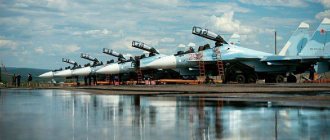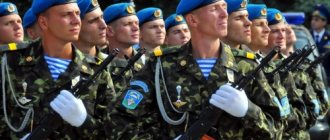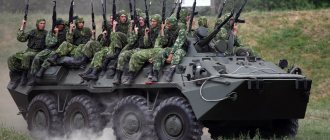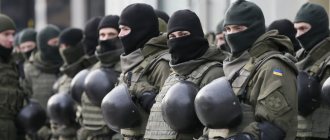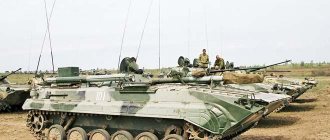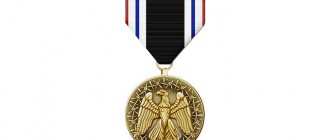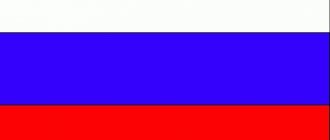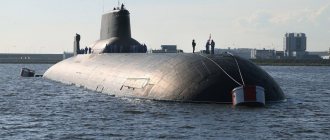The second half of the twentieth century can easily be called the “rocket age.” Humanity has been using missiles for quite a long time - but only in the middle of the last century the development of technology made it possible to begin their effective use, including as tactical and strategic weapons.
Today, rockets deliver astronauts into orbit, launch satellites into space, and with their help we study distant planets, but rocket technology has found much wider application in military affairs. It can be said that the advent of effective missiles has completely changed the tactics of warfare, both on land, in the air, and at sea.
With the advent of nuclear weapons, missiles have become the most powerful instrument of war, capable of destroying entire cities with millions of inhabitants. During the Cold War, humanity teetered for several decades on the brink of a global thermonuclear conflict that could have ended our civilization.
Currently, missiles with nuclear warheads are the main tool of deterrence, guaranteeing the inadmissibility of conflict between the world's largest players. Russia has one of the most powerful nuclear arsenals in the world, the most important part of our strategic nuclear triad being the Strategic Missile Forces, or Strategic Missile Forces.
The main type of weapons of the Strategic Missile Forces are intercontinental ballistic missiles with nuclear warheads, which can hit a target anywhere on the planet. The Strategic Missile Forces is a separate branch of the military, subordinate to the General Staff of the Russian Armed Forces. The Russian Missile Forces were formed on December 17, 1959. This date is the official Day of the Russian Missile Forces. The Military Academy of the Strategic Missile Forces is located in Balashikha (Moscow region).
The Russian army only has ballistic missiles. The Ground Forces of the RF Armed Forces include the Missile Forces and Artillery (RF&A), which are the main means of fire destruction of the enemy during combined arms operations. The missile defense forces are armed with multiple launch rocket systems (including high-power ones), operational and tactical missile systems, the missiles of which can be equipped with a nuclear warhead, as well as a wide range of cannon artillery.
“Land” missilemen have their own professional holiday - November 19 is the Day of the Russian Missile Forces and Artillery.
History of creation
Man began to launch rockets into the sky a very long time ago, almost immediately after the invention of gunpowder. There is information about the use of rockets for salutes and fireworks in Ancient China (from about the 3rd century BC). They tried to use missiles in military affairs, but due to their imperfections, they did not achieve much success at that time. Many prominent minds of the East and West were engaged in missiles, but they were more of an exotic curiosity than an effective means of defeating the enemy.
In the 19th century, Congreve missiles were adopted by the British army and were used for several decades. However, the accuracy of these missiles left much to be desired, so they were eventually replaced by cannon artillery.
Interest in the development of rocket technology reawakened after the end of the First World War. Design teams in many countries were engaged in practical work in the field of jet propulsion. And the results were not long in coming. Before the start of World War II, the USSR created the BM-13 multiple rocket launcher - the famous “Katyusha”, which later became one of the symbols of Victory.
In Germany, the development of new rocket engines was carried out by the brilliant designer Wernher von Braun, the creator of the first V-2 ballistic missile and the “father” of the American Apollo project.
During the war, several more examples of effective missile weapons appeared: a rocket-propelled grenade launcher (the German Faustpatron and the American Bazooka), the first anti-tank guided missiles, anti-aircraft missiles, and the V-1 cruise missile.
After the invention of nuclear weapons, the importance of rocket technology increased many times: rockets became the main carrier of nuclear charges. And if initially the United States could use strategic aircraft stationed at air bases in Europe, Turkey and Japan to launch nuclear strikes on Soviet territory, the Soviet Union could only rely on its strategic missiles in the event of a conflict.
The first Soviet ballistic missiles were created on the basis of captured German technologies; they had a relatively short flight range and could only perform operational tasks.
The first Soviet ICBM (flight range 8 thousand km) was the R-7 of the famous S. Korolev. It first started in 1957. With the help of the R-7, the first artificial Earth satellite was launched into orbit. In December of the same year, units with long-range ballistic missiles were separated into a separate branch of the military, and brigades armed with tactical and operational-tactical missiles became part of the Ground Forces.
In the 1960s, work on creating new types of artillery and missile systems for the Ground Forces was somewhat slowed down, since it was believed that they would be of little use in a global nuclear war. In 1963, operation of the new BM-21 Grad MLRS began, which is still in service with the Russian Armed Forces today.
In the 60-70s, the USSR began to deploy second-generation ICBMs, which were launched from highly protected launch silos. By the early 70s, at the cost of incredible efforts, nuclear parity with the Americans was achieved. During the same period, the first mobile ICBM launchers were created.
At the end of the 60s, the USSR began developing several self-propelled artillery systems, which later made up the so-called “flower” series: self-propelled guns “Akatsia”, “Gvozdika” and “Peony”. They are still in service with the Russian army today.
In the early 70s, an agreement was signed between the USSR and the USA to limit the number of nuclear weapons. After the signing of this document, the Soviet Union significantly surpassed the United States in the number of missiles and warheads, but the Americans had more advanced technologies, their missiles were more powerful and more accurate.
In the 70-80s, the Strategic Missile Forces received third-generation ICBMs with multiple warheads, and the accuracy of the missiles also increased significantly. In 1975, the famous “Satan” missile, the R-36M, was put into service, which for a long time was the main striking force of the Soviet Strategic Missile Forces, and then the Russian Missile Forces. In the same year, the Tochka tactical missile system was adopted by the Ground Forces.
At the end of the 80s, mobile and stationary systems of the fourth generation (Topol, RS-22, RS-20V) entered service with the missile forces, and a new control system was introduced. In 1987, the Smerch MLRS was adopted by the Ground Forces, which for many years was considered the most powerful in the world.
After the collapse of the USSR, all ICBMs from the former Soviet republics were removed to Russian territory, and the launch silos were destroyed. In 1996, the Strategic Missile Forces of the Russian Federation began to receive stationary-based fifth-generation ICBMs (Topol-M). In 2009-2010, regiments armed with the new Topol-M mobile complex were introduced into the Strategic Missile Forces.
Today, the replacement of obsolete ICBMs with more modern Topol-M and Yars complexes continues, and the development of the Sarmat heavy liquid-propellant missile continues.
In 2010, the United States and Russia signed another treaty regarding the number of nuclear warheads and their delivery vehicles - SALT-3. According to this document, each country can have no more than 1,550 nuclear warheads and 770 carriers for them. Carriers mean not only ICBMs, but also missile-carrying submarines and strategic aircraft.
Apparently, this treaty does not prohibit the production of missiles with multiple warheads, but at the same time it does not limit the creation of new elements of the missile defense system, which is what the United States is currently actively doing.
Development prospects
If we take into account weapons, then more than 70% of intercontinental ballistic missiles have simply exhausted their service life. In addition, most of the mobile missile systems based on railway trains, which received the NATO Stiletto classification, have been dismantled. It is also worth noting that Russia cannot partially cover the Atlantic and Pacific oceans.
At the same time, the latest missile attack warning stations were put into operation in the Krasnodar Territory, Kaliningrad and Leningrad regions. Four military satellites were launched into Earth orbit and became a key element of the Oko early warning system.
As the latest data show, today the total number of missile systems and missiles with nuclear warheads is not decreasing. They are being purposefully replaced with the latest developments, including the Topol-M and Yars mobile systems.
The most modern equipment that enters the Strategic Missile Forces requires qualified personnel. This task has been assigned to the Higher Educational Institution and military registration and enlistment offices. For example, when recruiting lower-level military personnel and junior command personnel, attention is paid to their education. Preference is given to those who have graduated from higher educational institutions with a technical background.
Structure, composition and armament of the Strategic Missile Forces
Today, the Strategic Missile Forces includes three armies: the 31st (Orenburg), the 27th Guards (Vladimir) and the 33rd Guards (Omsk), consisting of twelve missile divisions, as well as the Central Command Post and the Main Headquarters of the Missile Forces.
In addition to military units, the Strategic Missile Forces include several training grounds (Kapustin Yar, Sary-Shagan, Kamchatka), two educational institutions (an academy in Balashikha and an institute in Serpukhov), production facilities and bases for storing and repairing equipment.
Currently, the Strategic Missile Forces of the Russian Armed Forces are armed with 305 missile systems of five different types:
- UR-100NUTTKH – 60 (320 warheads);
- R-36M2 (and its modifications) – 46 (460 warheads);
- "Topol" - 72 (72 warheads);
- “Topol-M” (including silo and mobile versions) – 78 (78 warheads);
- "Yars" - 49 (196 warheads).
In total, the above complexes can carry 1166 nuclear warheads.
The central command post (CCP) of the Strategic Missile Forces is located in the village of Vlasikha (Moscow region), it is located in a bunker at a depth of 30 meters. There are four rotating shifts on continuous combat duty. The communications equipment of the Central Command Center allows you to maintain continuous communication with all other posts of the missile forces and military units, receive information from them and respond to it in a timely manner.
Russian strategic nuclear forces use the Kazbek automated combat control system, its portable terminal - the so-called “black suitcase”, which is constantly kept by the President of the Russian Federation; the Minister of Defense and the Chief of the General Staff have similar “suitcases”. Currently, work is underway to modernize the automated control system; the new fifth-generation system will make it possible to quickly retarget ICBMs, as well as communicate orders directly to each launcher.
The Strategic Missile Forces of the Russian Federation are equipped with a unique “Perimeter” system, which in the West was nicknamed “Dead Hand”. It makes it possible to strike back at the aggressor, even if all command and control links of the Strategic Missile Forces are destroyed.
Currently, the Strategic Missile Forces are being rearmed with new Yars missiles with multiple warheads. Tests of a more advanced modification of the Yars, the R-26 Rubezh, have been completed. Work is underway to create a new heavy missile “Sarmat”, which should replace the outdated Soviet “Voevoda”.
The development of the new Barguzin railway missile system continues, but its testing dates are constantly being postponed.
Celebration traditions and official events
Since 1995, on Strategic Missile Forces Day, a gala reception has been held in the Kremlin to mark the holiday. In military units and military academies, ceremonial events are held: formations, festive concerts. Military personnel are assigned new ranks, awards and incentives.
View this post on Instagram
A post shared by Victor Ray (@v1cr4v)
Photo: Missile systems at the parade
Ilya Muromets (Ilya Pechersky) is considered the heavenly patron of the missile forces. The Orthodox Church venerates it on December 19 according to the old style or January 1 according to the new style. On the day of Ilya Muromets, it was supposed to remember the heroic deeds of our ancestors and bow to Mother Earth. Therefore, on Strategic Missile Forces Day, military personnel visit churches and make donations.
There are no culinary traditions associated with the professional holiday among rocket scientists. But there is a custom to serve roasted pig on the day of Ilya of Muromets. It is associated with the onset of the New Year. The dish was served simply fried or stuffed and baked until crispy.
In 1995, Patriarch Alexy II proclaimed Saint Barbara, whose memory is honored by the Orthodox Church on December 17, as the patroness of the Strategic Missile Forces. The icon of St. Barbara was presented to the command of the missile forces and today is located in the command post of the Strategic Missile Forces.
Similar holidays in other countries
The profession of a rocket scientist “grew” from the profession of an artilleryman. Therefore, another holiday was the first to appear in Russia - the Day of Missile Forces and Artillery. Celebrated on November 19. The date of the celebration was the day of the beginning of the Soviet counter-offensive in the Battle of Stalingrad, Operation Uranus. On October 21, 1944, by decree of the Presidium of the USSR Armed Forces, Artillery Day was established.
Belarus and Kazakhstan continue to celebrate the professional holiday of rocket scientists on Artillery Day - November 19. In Ukraine there is no holiday dedicated to the strategic missile forces, but the Day of Missile Forces and Artillery is celebrated on November 3.
In the United States, separate holidays for each branch of the military existed until 1949. On August 31, 1949, Secretary of Defense Louis Johnson announced instead a single Army, Navy and Air Force Day, which falls on May 20. The holiday is intended to showcase the success of the armed forces in defending the country. It is held in the form of parades. Just like in Russia, on this day in military units, personnel are presented with awards and given new ranks.
The Rocket Forces are among the most secretive units of the armed forces. They try not to advertise their activities and everyday life to the public, with the exception of demonstrating their military potential at ceremonial parades. But on Strategic Missile Forces Day, servicemen are sure to congratulate their colleagues, accept congratulations from relatives and celebrate the holiday with friends and family.
